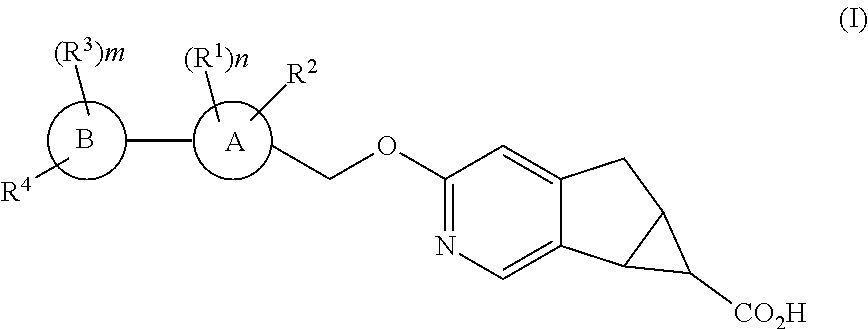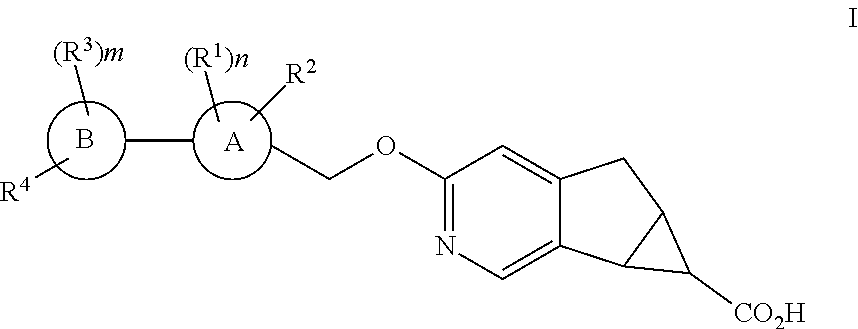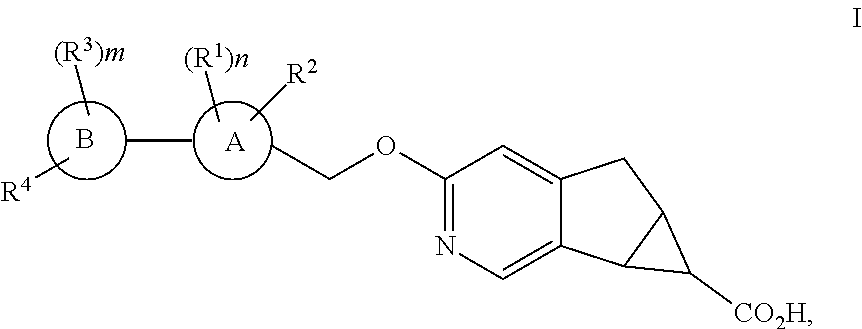Antidiabetic tricyclic compounds
a tricyclic compound and antidiabetic technology, applied in the field of antidiabetic tricyclic compounds, can solve the problems of increased and premature morbidity and mortality, inadequate insulin-mediated repression of lipolysis in adipose tissue, oxidation and storage of glucose in muscle,
- Summary
- Abstract
- Description
- Claims
- Application Information
AI Technical Summary
Benefits of technology
Problems solved by technology
Method used
Image
Examples
example 1
[0506]
(5aR,6S,6aS)-3-{[3′,4-difluoro-4′-(((1s,3s)-3-hydroxy-3-methylcyclobutyl)methoxy)-6-(trifluoromethyl)-[1,1′-biphenyl]-3-yl]methoxy}-5,5a,6,6a-tetrahydrocyclopropa[4,5]cyclopenta[1,2-c]pyridine-6-carboxylic acid
[0507]
Step A: (1s,3s)-3-(hydroxymethyl)-1-methylcyclobutanol
[0508]To a solution of (1s,3s)-3-hydroxy-3-methylcyclobutanecarboxylic acid (2.00 g, 15.4 mmol) in THF (30 ml) at 0° C. was added borane-THF complex (30.7 ml, 30.7 mmol) dropwise. It was stirred at 0° C. for an hour and room temperature overnight. It was quenched with methanol (30 ml) at 0° C. The reaction mixture was concentrated under reduced pressure. The residue was purified by chromatography over silical gel (eluting with a gradient of hexanes:EtOAc 100:0 to 50:50, to give the title compound. 1HNMR (500 MHz, CDCl3) δ: 3.65 (t, 2H, J=5.1 Hz), 2.17-2.21 (m, 2H), 2.05-2.14 (m, 1H), 1.83-1.87 (m, 2H), 1.39 (s, 3H).
Step B: (5aR,6S,6aS)-ethyl 3-{[3′,4-difluoro-4′-hydroxy-6-(trifluoromethyl)-[1,1′-biphenyl]-3-yl]m...
example 2
[0512]
(5aR,6S,6aS)-3-{[3′,4,5′-trifluoro-4′-(((1s,3s)-3-hydroxy-3-methylcyclobutyl)methoxy)-6-(trifluoromethyl)-[1,1′-biphenyl]-3-yl]methoxy}-5,5a,6,6a-tetrahydrocyclopropa[4,5]cyclopenta[1,2-c]pyridine-6-carboxylic acid
[0513]
Step A: (5aR,6S,6aS)-ethyl 3-{[3′,4,5′-trifluoro-4′-hydroxy-6-(trifluoromethyl)-[1,1′-biphenyl]-3-yl]methoxy}-5,5a,6,6a-tetrahydrocyclopropa[4,5]cyclopenta[1,2-c]pyridine-6-carboxylate
[0514]A mixture of (5aR,6S,6aS)-ethyl 3-{[5-bromo-2-fluoro-4-(trifluoromethyl)-benzyl]oxy}-5,5a,6,6a-tetrahydrocyclopropa[4,5]cyclopenta[1,2-c]pyridine-6-carboxylate (850 mg, 1.79 mmol), (3,5-difluoro-4-hydroxyphenyl)boronic acid (468 mg, 2.69 mmol), and chloro(2-dicyclohexyl-phosphino-2′,4′,6′-triisopropyl-1,1′-biphenyl)[2-(2′-amino-1,1′-biphenyl)] palladium(II) (212 mg, 0.269 mmol) was degassed and purged with nitrogen three times. THF (12 ml) and 1M potassium phosphate tribasic (5.40 ml, 5.40 mmol) were added. The reaction mixture was stirred at 65° C. overnight, then cooled to...
example 3
[0517]
(5aR,6S,6aS)-3-{[3′,4,5′-trifluoro-4′-(((1r,4r)-4-hydroxy-4-methylcyclohexyl)oxy)-6-(trifluoromethyl)-[1,1′-biphenyl]-3-yl]methoxy}-5,5a,6,6a-tetrahydrocyclopropa[4,5]cyclopenta[1,2-c]pyridine-6-carboxylic acid
[0518]
Step A: (5aR,6S,6aS)-ethyl 3-{[3′,4,5′-trifluoro-4′-(((1r,4r)-4-hydroxy-4-methylcyclohexyl) oxy)-6-(trifluoromethyl)-[1,1′-biphenyl]-3-yl]methoxy}-5,5a,6,6a-tetrahydrocyclopropa[4,5]cyclopenta[1,2-c]pyridine-6-carboxylate
[0519]To a solution of (5aR,6S,6aS)-ethyl 3-{[3′,4,5′-trifluoro-4′-hydroxy-6-(trifluoromethyl)-[1,1′-biphenyl]-3-yl]methoxy}-5,5a,6,6a-tetrahydrocyclopropa-[4,5]-cyclopenta[1,2-c]pyridine-6-carboxylate (400 mg, 0.764 mmol) in DCM (3 ml) and THF (3 ml) at ambient temperature were added (1s,4s)-1-methylcyclohexane-1,4-diol (129 mg, 0.993 mmol), di-tert-butyl diazene-1,2-dicarboxylate (229 mg, 0.993 mmol), and polymer-bound triphenylphosphine (401 mg, 1.53 mmol) (˜3 mmol / g). The reaction mixture was stirred at room temperature overnight, then filtered...
PUM
| Property | Measurement | Unit |
|---|---|---|
| Pharmaceutically acceptable | aaaaa | aaaaa |
Abstract
Description
Claims
Application Information
 Login to View More
Login to View More - R&D
- Intellectual Property
- Life Sciences
- Materials
- Tech Scout
- Unparalleled Data Quality
- Higher Quality Content
- 60% Fewer Hallucinations
Browse by: Latest US Patents, China's latest patents, Technical Efficacy Thesaurus, Application Domain, Technology Topic, Popular Technical Reports.
© 2025 PatSnap. All rights reserved.Legal|Privacy policy|Modern Slavery Act Transparency Statement|Sitemap|About US| Contact US: help@patsnap.com



